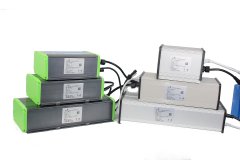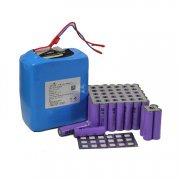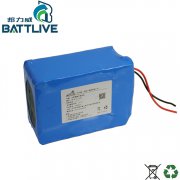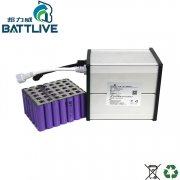Energy Density (Wh/L & Wh/kg)
The energy released by a cell per unit volume or mass.
If it is a unit volume, that is, volume energy density (Wh/L), many places are directly referred to as energy density.
If it is a unit mass, it is the mass energy density (Wh/kg), which is also called specific energy in many places.
If a lithium battery weighs 300 g, rated voltage is 3.7 V and capacity is 10 A h, its specific energy is 123 Wh/kg.
According to the 16-year "Road Map of Energy-saving and New Energy Vehicle Technology", we can have a concept about the development trend of power battery. As shown in the figure below, the specific energy of pure electric vehicle battery will reach 350 Wh/kg by 2020.
Power density (W/L & W/kg)
Divide energy by time and you get power in W or kW. Similarly, power density refers to the output power per unit mass (or in some places, directly called specific power) or per unit volume of batteries, in W/kg or W/L.
Specific power is an important index to evaluate whether the battery meets the acceleration performance of electric vehicles.
What is the difference between specific energy and specific power?
Take an example of image:
Power batteries with higher specific energy are like tortoises in tortoise and rabbit races. They have good endurance and can work for a long time to ensure that the car has a long range.
Power batteries with high specific power are like rabbits in tortoise and rabbit races. They are fast and can provide high instantaneous current to ensure good acceleration performance.
The following parameters are slightly tortuous.
Battery discharge rate (C)
Discharge rate is the current value required to discharge its rated capacity (Q) in a specified time, which is equal to the multiple of the rated capacity of the battery in value. Namely: Charge and Discharge Current (A)/Rated Capacity (Ah), whose unit is C (C-rate abbreviation), such as 0.5C, 1C, 5C, etc.
For example, for 244h batteries:
When discharged at 48A, the discharge rate is 2C. Conversely, when discharged at 2C, the discharge current is 48A, and the discharge is completed in 0.5 hours.
Charging with 12A, the charging rate is 0.5C. Conversely, charging with 0.5C, the charging current is 12A, and charging is completed in 2 hours.
The charge-discharge ratio of batteries determines how fast we can store a certain amount of energy in the batteries, or how fast we can release the energy in the batteries.
Charged state (%)
SOC, full name is State of Charge, the state of charge, also known as residual power, represents the ratio of the residual capacity of the battery after discharge to the capacity of its fully charged state.
It ranges from 0 to 1. When SOC = 0, the battery discharges completely, and when SOC = 1, the battery is fully charged. Battery Management System (BMS) is mainly to ensure the efficient operation of batteries by managing SOC and estimating, so it is the core of battery management.
At present, SOC estimation mainly includes open-circuit voltage method, ampere-time measurement method, artificial neural network method, Kalman filter method and so on. We will explain it in detail later.
internal resistance
Internal resistance refers to the resistance of the current flowing through the battery when the battery is working. It includes ohmic internal resistance and polarization internal resistance. Among them, ohmic internal resistance includes electrode material, electrolyte, diaphragm resistance and resistance of parts; polarization internal resistance includes electrochemical polarization resistance and concentration polarization resistance.
Speaking with data, the following chart shows a battery discharge curve, the X axis represents the discharge amount, the Y axis represents the open circuit voltage of the battery, the ideal discharge state of the battery is a black curve, and the red curve is the real state when considering the internal resistance of the battery.
Figure: Qmax is the maximum chemical capacity of the battery; Quse is the actual capacity of the battery; Rbat is the internal resistance of the battery; EDV is the discharge termination voltage; I is the discharge current;
As can be seen from the figure, the actual capacity of the battery Quse < the theoretical maximum chemical capacity of the battery Qmax. Due to the existence of resistance, the actual capacity of the battery will be reduced. We can also see that the actual battery capacity Quse depends on two factors: the product of discharge current I and battery internal resistance Rbat, and the discharge termination voltage EDV. It should be pointed out that Rbat will gradually increase with the use of batteries.
The unit of internal resistance is usually milliohm (m_). The battery with large internal resistance consumes a lot of internal power and heats seriously during charging and discharging, which will cause accelerated aging and life degradation of the battery, and also restrict the application of high-rate charging and discharging. Therefore, the smaller the internal resistance is, the better the battery life and rate performance will be. Usually, AC and DC methods are used to measure the internal resistance of batteries.
Self discharge
Battery self-discharge refers to the phenomenon of voltage drop in the process of open circuit static, also known as battery charge-holding capacity.
Generally speaking, the self-discharge of batteries is mainly affected by manufacturing technology, materials and storage conditions. Self-discharge can be divided into two kinds according to whether the capacity loss is reversible or not: capacity loss is reversible, which means that the capacity can be recovered after recharging; capacity loss is irreversible, which means that the capacity can not be recovered.
At present, there are many theories on the causes of battery self-discharge, which can be divided into physical reasons (storage environment, manufacturing process, materials, etc.) and chemical reasons (instability of electrodes in electrolyte, internal chemical reactions, consumption of active materials, etc.). Self-discharge of battery will directly reduce the capacity and storage performance of battery. 。
Life
The battery life is divided into two parameters: cycle life and calendar life. Cyclic life refers to the number of times a battery can be recharged or discharged. That is to say, at ideal temperature and humidity, charging and discharging are carried out with rated charging and discharging current, and the number of cycles experienced when the battery capacity decreases to 80%.
Calendar life refers to the time span of battery life termination condition (capacity attenuation to 80%) under specific operating conditions. Calendar life is closely related to the specific requirements of use. Usually, it is necessary to specify specific operating conditions, environmental conditions, storage intervals and so on.
Cyclic life is a theoretical parameter, and calendar life is more practical. However, the calculation of calendar life is complex and time-consuming, so battery manufacturers usually only give the data of cycle life.
The above figure is a charge-discharge characteristic diagram of ternary lithium batteries. It can be seen that different charging and discharging modes have different effects on the life of batteries. For example, the life of batteries with 25% - 75% charging and discharging can reach 2500 times, which is what we call shallow charging and shallow discharging. The topic of battery life will be discussed in depth in the future.
















